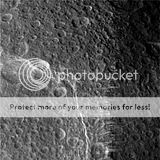3
3488
Guest
Thank you very much EarthlingX. Fascinating stuff.
What is very apparent as you say is that Tethys appears far brighter than Dione. However a surface that has seen geological activity of which Dione has seen plenty of IMO would be brighter as it would have had less time to accumulate a darkening dusty layer & darken due to the weak UV radiation from the Sun at that distance.
Here is an oxymoron. Tethys appears far more primitive than Dione, peppered with craters & has the Ithaca Chasmata, which can be explained as a fracture in the more brittle ice crust of Tethys ruptured when the slushy interior froze.
Dione appears to be the most internally differentiated of Saturn's moons, even more so than Titan which is a huge surprise (Titan under the icy crust appears to be more like Jupiter's moon Callisto, an undifferentiated ball of rock & ice, also more like Rhea too).
Tethys on the other hand apears to be a giant undifferentiated ball of ice with perhaps a small amount of rocky material. Tethys does have a 'smoother' band around the equator with slightly smaller craters, but this too is ancient. Dione has crumple zones, thrust faulting, possible cryovolcanic resurfacing in a few places, certainly appears more evolved than Tethys.
Fascinating stuff.
Andrew Brown.
What is very apparent as you say is that Tethys appears far brighter than Dione. However a surface that has seen geological activity of which Dione has seen plenty of IMO would be brighter as it would have had less time to accumulate a darkening dusty layer & darken due to the weak UV radiation from the Sun at that distance.
Here is an oxymoron. Tethys appears far more primitive than Dione, peppered with craters & has the Ithaca Chasmata, which can be explained as a fracture in the more brittle ice crust of Tethys ruptured when the slushy interior froze.
Dione appears to be the most internally differentiated of Saturn's moons, even more so than Titan which is a huge surprise (Titan under the icy crust appears to be more like Jupiter's moon Callisto, an undifferentiated ball of rock & ice, also more like Rhea too).
Tethys on the other hand apears to be a giant undifferentiated ball of ice with perhaps a small amount of rocky material. Tethys does have a 'smoother' band around the equator with slightly smaller craters, but this too is ancient. Dione has crumple zones, thrust faulting, possible cryovolcanic resurfacing in a few places, certainly appears more evolved than Tethys.
Fascinating stuff.
Andrew Brown.























































